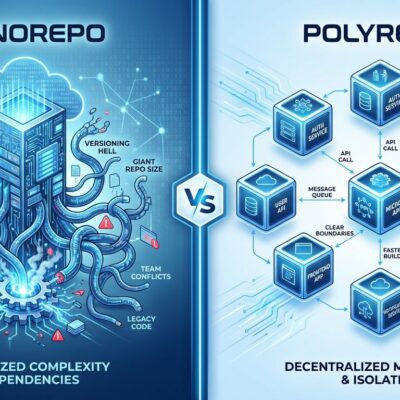
Node.js has dominated JavaScript runtimes for 13 years. Bun 1.1, released this November, might finally end that reign — but only if you migrate for the right reasons. Version 1.1 marks Bun’s production-readiness milestone with critical stability fixes, 99% npm compatibility, and performance that makes Node.js look slow. Startup time is 3x faster. Package installs run 20x quicker. HTTP throughput jumps 2.75x. The migration path is straightforward for most applications, but knowing when NOT to migrate matters as much as knowing how.
Should You Actually Migrate?
Migrating because Bun is “faster” is lazy reasoning. Migrate because the performance gains solve actual problems and the stability tradeoffs are acceptable.
Migrate NOW if you’re running:
Serverless functions where cold start time determines AWS bills. Bun’s 20ms startup vs Node’s 60ms cuts Lambda execution costs by 40%. Microservices handling high request volume benefit from 110k requests/sec throughput instead of Node’s 40k. Developer tooling and CLIs need instant responsiveness — Bun’s fast startup eliminates the lag. Monorepo workspaces waste hours on package installs; Bun turns 10-minute CI pipelines into 2 minutes. New projects have zero migration cost, so defaulting to Node.js in 2025 means choosing to be slower for no reason.
Don’t migrate if you’re running:
Enterprise systems where Node’s 13 years of production hardening outweigh performance gains. Applications with heavy native module usage will hit compatibility walls — bcrypt, sharp, and node-canvas require workarounds. Windows-first development teams should wait; Bun’s Windows support improved but still lags behind Linux and Mac. Mission-critical financial or healthcare systems need stability over speed. For these cases, monitor Bun’s maturity and revisit in 6-12 months.
Decision rule: If a 40% performance gain is worth a 5% stability risk, migrate. If not, wait.
Migration Preparation
Check compatibility before changing anything. Run a dependency audit to verify your npm packages work with Bun. The rule: if 95% of your dependencies are compatible, proceed. Most popular packages work flawlessly — React, Express, TypeScript, Next.js. The 1% that don’t are mostly obscure native modules.
Set up dual-runtime testing. Keep Node.js installed and add Bun for side-by-side comparison. This lets you validate behavior and roll back instantly if issues appear.
Benchmark current performance. Measure startup time, HTTP requests per second, and package install duration under Node.js. You’ll compare these to Bun later to validate the migration delivered actual gains.
Step-by-Step Migration
Install Bun 1.1:
curl -fsSL https://bun.sh/install | bashUpdate package.json scripts to replace node commands with bun:
{
"scripts": {
"dev": "bun run index.js",
"start": "bun run server.js",
"test": "bun test"
}
}Install dependencies using Bun’s package manager:
bun installThis command replaces npm install and runs 20x faster. Your node_modules remain compatible.
Run your test suite:
bun testBun includes a built-in test runner compatible with Jest syntax. Most tests work without modification.
Fix any breaking issues. You’ll likely hit 1-3 gotchas depending on your dependency stack. The next section covers the most common problems and solutions.
Benchmark performance improvements. Re-run the metrics you captured earlier. Expect 3x faster startup, 2.75x higher HTTP throughput, and dramatically faster package installs.
Common Gotchas and How to Fix Them
Native modules break: Packages like bcrypt, sharp, and sqlite3 use node-gyp compilation and may fail on Bun.
Fix: Replace bcrypt with bcryptjs (pure JavaScript, identical API). Use sharp’s experimental WASM build. For SQLite, use Bun’s built-in database instead of the sqlite3 npm package.
// Before (Node.js with bcrypt)
const bcrypt = require('bcrypt');
// After (Bun with bcryptjs)
const bcrypt = require('bcryptjs'); // Same API, zero code changesGlobal object differences: Code checking process.versions.node will fail because that property doesn’t exist in Bun.
Fix: Use feature detection or check for process.versions.bun:
// Before
if (process.versions.node) { ... }
// After
if (process.versions.bun || process.versions.node) { ... }Environment variable loading: The dotenv package behaves slightly differently in Bun.
Fix: Nothing. Bun loads .env files automatically without requiring dotenv. Remove the dotenv dependency.
Debugging tools downgrade: Bun uses JavaScriptCore instead of V8, so the Chrome DevTools inspector doesn’t work.
Fix: Use Bun’s built-in debugger or rely on console.log for now. This is a mild developer experience downgrade, not a blocker.
Windows path handling inconsistencies: Path separators behave unpredictably on Windows.
Fix: Always use path.join() instead of string concatenation. Test thoroughly on Windows if you deploy there.
Benchmark the Results
Validate that migration delivered the performance improvements you expected.
Measure startup time:
time bun run index.js
time node index.jsExpect Node at ~60ms, Bun at ~20ms. That’s a 3x improvement.
Test HTTP throughput using a load testing tool like wrk:
bun run server.js &
wrk -t4 -c100 -d30s http://localhost:3000Node.js typically handles 40,000 requests/second. Bun should hit 110,000 requests/second — a 2.75x gain.
Compare package install speed:
time npm install # Node: ~8 seconds for 100 packages
time bun install # Bun: ~0.4 secondsA 20x speedup transforms CI/CD pipelines. A 10-minute build drops to 2 minutes just from faster dependency installation.
Real-world impact: Serverless functions on AWS Lambda see 40% cost reduction because faster execution means lower compute bills. Developer experience improves dramatically with instant feedback loops.
Deploying to Production
Docker configuration for Bun 1.1:
FROM oven/bun:1.1
WORKDIR /app
COPY package.json bun.lockb ./
RUN bun install --frozen-lockfile
COPY . .
CMD ["bun", "run", "start"]GitHub Actions CI/CD:
- uses: oven-sh/setup-bun@v1
with:
bun-version: 1.1
- run: bun install
- run: bun testRollback strategy matters. Keep your Node.js Docker image tagged and ready. Use a feature flag to toggle between Bun and Node runtimes if possible. Monitor error rates obsessively for the first 48 hours. If anything breaks, one command reverts the deployment.
Monitor these metrics: Error rates should stay flat or decrease. Memory usage should be similar to Node. Startup times should drop 3x. If error rates spike, roll back immediately and investigate.
The Verdict
Bun 1.1 is production-ready for performance-critical applications where speed solves real problems. The migration process is straightforward — install Bun, update scripts, fix 1-3 gotchas, deploy. Performance gains are measurable and significant: 3x faster startup, 20x faster installs, 2.75x higher throughput.
But production-ready doesn’t mean enterprise-ready. Node.js has 13 years of battle-hardening. Bun has 2 months of version 1.x stability. For new projects and performance-critical systems, Bun is the obvious choice. For mission-critical applications, wait until Bun’s ecosystem matures further.
Migrate smartly. Test thoroughly. Monitor obsessively. The future is faster, but fast deployments that crash aren’t deployments — they’re rollbacks.












